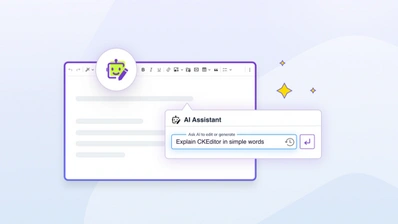Choosing and Integrating the Best AI Content Creation Tools in 2025 (Free & Paid Options Reviewed)

Businesses generate tons of time-intensive content, including reports, emails, technical documentation, blogs, and more. AI speeds up the creation process.
But with so many AI content creation tools crowding the market, how do you choose? Testing everything is impractical, so it’s important to narrow your list.
In this guide, we review the top AI content creation tools across three main categories: general-purpose AI assistants, specialized, purpose-focused products, and rich text editors with embedded AI. While these tools are primarily designed for end users, developers and product teams need to evaluate them carefully before integrating them into applications or workflows. Each review highlights business value, with additional developer notes for teams planning integrations.
Key benefits of AI content tools in 2025
Business users are increasingly using AI content creation tools in their workflows. These products provide several critical benefits, including:
-
Improved productivity: Generate outlines, summaries, and even final content for short-form writing.
-
Consistency: Get tone, grammar, and style reviews and suggestions. Plus, you can add info for additional context to produce more accurate responses.
-
Inspiration: Generate outlines or get assistance when faced with writer’s block.
-
AI collaboration: Beyond brainstorming, you can use AI to get feedback and revise drafts. This leads to higher-quality content due to revisions.
How we chose the best AI content tools
To help you select the right tools, we reviewed eight popular options using publicly available information. You’ll learn the strengths and weaknesses of each for both end users and developers. We review the differences between free and paid options (most services offer both), but exclude pricing since it fluctuates over time.
8 best AI content tools in 2025
AI content creation tools fall into several categories. These include:
-
General-purpose AI: General-purpose AI tools are the household names for AI. Companies in this category develop and provide foundational LLM models and typically offer a consumer-facing chat interface. Examples include ChatGPT and Google Gemini.
-
Specialized AI tools: These support use cases such as marketing, sales, SEO, or optimizing content for readers. They often provide features like content outlines, tone and style suggestions, plagiarism detection, and SEO analysis.
-
Rich text editors with embedded AI: RTEs give users the ability to create nearly any type of content, whether internal or external. Developers add these composable elements directly into their applications or workflows. Embedded AI enhances the user experience and boosts quality and productivity.
ChatGPT (OpenAI)
Best used for: Tasks like brainstorming, researching, generating drafts, and answering quick questions.
You likely know this one. ChatGPT was the biggest mainstream breakout player, offering a series of AI models (most recently GPT-5) both within the ChatGPT application and for use in other applications. Provided by OpenAI, ChatGPT creates engaging, human-like answers to AI prompts. ChatGPT scores points for ease of use and setup. With ChatGPT, you get versatility. You can generate outlines, create content, get feedback, proofread, or even research. In fact, ChatGPT offers its deep research features to provide well-sourced answers to questions.
Some limitations include:
-
Hallucinations: Any generative AI model will hallucinate since its output is probabilistic. It’s not unique to ChatGPT (or GPT models or products). Regardless, human oversight is a must.
-
Rate limiting: For end users, the release of GPT-5 introduced tight rate limits on free plans, capping requests over a given time period. Paid plans offer looser limits.
-
Model selection: ChatGPT automatically routes to the most appropriate models. Free plan users can’t sidestep this, but paid users can select specific models if they prefer. However, developers using an API subscription can select which model to use for their application.
Developer notes: OpenAI provides a robust developer platform with clear documentation, REST APIs, and official SDKs for Node and Python. You’re billed based on a token-based usage model, leading to varying costs. Common use cases include stateful assistants, multimodal applications, agentic workflows, or integration with server-side applications at scale.
Google Gemini
Best for: General-purpose AI tasks, especially if your organization is already connected to the Google ecosystem.
Gemini is Google’s answer to ChatGPT. Integrated across Gmail, Drive, Docs, and Google Search, Gemini fits naturally into workflows for anyone using Google Workspace. It offers strong multimodal capabilities to accept inputs across text, audio, and video. Deep research capabilities shine here as well, producing research reports with cited sources.
While subjective, some may find that Gemini produces less personable outputs than ChatGPT. This comes down to personal preference. Similar to ChatGPT, Gemini can hallucinate and provide incorrect answers with confidence. Human oversight is advised.
Developer notes: Gemini access occurs through Google Cloud. Developers can access detailed docs, quickstarts, and SDKs for Python, Node, and Go. To use Gemini as a developer, you must have a Google Cloud Project and standard authorization. Please note that Google does offer free trial credits. Developers can build a variety of projects, such as multimodal assistants, long-context reasoning applications, and low-latency live interactions via the live API. Gemini can easily be integrated into other Google workflows. Plus, a partnership with Stack Overflow further enhances developer resources.
CKEditor AI
Best for: Organizations that want a complete AI content creation suite in any application or workflow.
CKEditor is a composable rich text editor that can be added to any type of application. It’s equally useful for externally facing content creation like content management systems, internal communications tools like intranets, or interpersonal communication applications like parts of customer support applications or email services.
In Q4, the company released CKEditor AI, a new suite of AI features powered by CKEditor Cloud Services. This add-on goes beyond simple API calls to LLMs, providing an end-to-end AI experience with built-in logic and ready-made components that teams would otherwise have to build themselves.
Some key features include:
-
Conversational AI for quick brainstorming and drafting in context
-
Customizable AI actions for one-click rewriting, summarization, or corrections
-
Customizable AI-assisted document review for consistency and compliance
-
Context settings—such as scraping websites, uploading files, pulling in relevant content from the application (like other documents, posts, or user-created text), and enabling web search—to minimize AI hallucinations and generate more accurate responses
-
Ready-made UIs for AI writing
Additionally, CKEditor AI solves one of the most common challenges for users: switching between AI tools. The new AI release for CKEditor embeds a full AI suite directly within an editing environment.
CKEditor requires setup and configuration, but comes with thorough API documentation, examples, and use cases. Every feature is API-driven and built for developers, so please involve your dev team in the review process. Keep in mind that AI features are premium and won’t be available in the free edition once the trial ends.
Developer notes: CKEditor is fully modular and composable and exposes functionality through APIs and SDKs for frameworks like React, Angular, Vue, and vanilla JavaScript. You can customize AI actions, extend the editor with plugins, and adapt the UI to fit your applications.
Built to scale, CKEditor supports enterprise deployments and real-time collaboration. It meets SOC 2 Type 2, ISO/IEC 27001, GDPR, and WCAG A & AA standards and is EAA-ready, with enterprise-grade security features. A rich ecosystem of plugins, add-ons, and long-term support makes it a future-proof choice for embedding rich text editing and AI.
Jasper AI
Best for: Marketing teams and agencies that produce high volumes of content while maintaining a consistent brand voice.
Jasper AI is a strong AI platform that offers robust content capabilities for all employees, especially marketers. You’ll enjoy features like brand voice recognition, knowledge assets, style guides, and collaboration tools. It offers pre-built templates to get teams started, using best practices for each content type. Integrations with other tools like Zapier and SurferSEO help make this a broad marketing platform with a lot of versatility.
Of course, Jasper AI also has some limitations. Common concerns include:
-
Higher price point: You’re paying a premium when using Jasper AI. Extra features may make Jasper AI worth it, but make sure to price out options.
-
Learning curve: As a feature-rich platform, Jasper AI has a potentially steep learning curve, with some users saying it can take a few weeks to get comfortable. This can slow end user adoption.
-
Heavy marketing focus: The main selling point as a marketing-centric tool can also be a trade-off. For internal communications and documents, you might opt for a general-purpose AI model or a rich text editor instead.
Developer notes: The API exposes endpoints for commands, templates, retrieval add-ons, and its AI engines. Access requires an API key from the Jasper AI workspace and access to a qualifying Jasper plan. Developers typically use Jasper applications for bulk content generation, automated workflows, and template-driven content workflows. Compared to general-purpose AI, the API is more limited, but focused. It’s optimized for marketing tasks.
Copy.ai
Best for: This platform is also a strong option for marketing teams, especially for creating strong, short-form copy at scale.
Copy.ai users enjoy this product for its ease of use and clean, intuitive user interface. Users can select from more than 90 templates, several starting and premium content tones, and more than 29 languages. The service offers access to multiple underlying LLMs, adding versatility and choice. While often used by marketing, the platform offers strong features for sales and operations teams as well. This could be overkill for pure content generation, but having a full platform in your corner can be a solid strategic choice.
While Copy.ai offers multiple integrations with other tools, these require additional setup. Additionally, Trustpilot reviews rate this service with a low number (as of September 2025), with some reviews citing poor customer service. Please take reviews as a single data point, as your experience could vary. Some users have claimed that Copy.ai peters out a bit on longer-form content generation, potentially losing context over several paragraphs, but again, test this yourself before writing anything off.
Developer notes: API access is available only through the enterprise plan. API keys are created and managed from the Copy.ai dashboard. You can build programmatic workflow executions, webhook-driven automations, and integrations that surface the service’s assets in other tools. Integrations use server-side calls to trigger workflows, register webhooks for run completions, and integrate with internal tooling. The Workflows API primarily focuses on pre-built workflows as building blocks, making this more platform-oriented than general-purpose AI offerings.
Writesonic
Best for: If you want an AI writer tool with extensive SEO integrations.
Writesonic is a comprehensive platform for AI content creation. It includes several models, 80+ templates, support for more than 24 languages, and the ability to add keyword suggestions for an article. It also includes a built-in SEO checker that helps fix technical SEO problems. Plus, Writesonic offers insights to optimize for AI-assisted search, which is crucial as searchers increasingly rely on AI summaries.
For limitations, Writesonic’s writing quality output can vary. This isn’t unique to Writesonic, as any generative AI solution should require oversight and editing to make it production-ready. But still, Writesonic can get you started on a lot of your content. Some users have mentioned confusing pricing and billing. Plus, as a tool emphasizing customer-facing content, it’s not ideal for internal documentation or communications, which might be better served with a rich text editor or a general-purpose AI model.
Developer notes: Writesonic offers strong public API documentation and reference endpoints as well as an API dashboard. Writesonic offers a lot of versatility in what you can build, including SEO/marketing content generation, chat-style assistants via Chatsonic, and CMS integrations. Integrations occur primarily via server-to-API patterns with API keys. Enterprise customers can also request custom-trained AI models via API.
Frase
Best for: SEO strategists, writers, and content teams producing authoritative SEO content at scale.
Frase is an AI content creation tool focused on SEO. It analyzes the top articles for a given keyword to inform how users can optimize their articles. Writers compare their article against an optimization score, helping them create articles that rank. It also comes replete with templates and generates full data-driven content briefs, helping you more quickly create authoritative articles loved by search engines. Frase does go beyond SEO, offering templates for AI-generated emails and captions.
For limitations, Frase doesn’t offer pure built-in keyword research, so users will have to supplement with other keyword research tools. While users can write up to 10,000 words on the Frase free plan, unlimited AI-generated writing only works with an unlimited plan. Frase does offer templates for shorter form content, but the primary focus remains on longer-form SEO.
Developer notes: Frase offers a strong API with some rate limits. Pricing includes pay-as-you-go documents as well as other options for plan-based features. As an SEO-based tool, your team can primarily build SEO-driven applications such as programmatic SERP and document analysis, automated content briefs, document retrieval, and SEO/optimization data into content pipelines. Most development work tackles connecting Frase to internal tools, rather than developing new features or applications on top of the Frase API.
Grammarly
Best for: Any writer looking for a robust, AI-driven grammar, spelling, and content style solution to improve readability.
Grammarly is a long-term player in the content creation market, founded in 2009. Over the years, it has remained a mainstay to improve users’ writing, implementing new features that evolve with the times. This includes suggestions related to tone, clarity, and even the ability to rewrite paragraphs or sections with AI. It’s a fantastic supplement for any content creator looking to enhance their writing.
Grammarly works best as a collaborator for improving content, not necessarily writing from scratch. It has carved out an important editorial niche, but the original Grammarly product isn’t as versatile as marketing tools, rich text editors or general-purpose AI tools (although, GrammarlyGO does offer more enterprise generative AI capabilities). Additionally, Grammarly does paywall several premium features, so the free version is limited (but still very useful).
Developer notes: As part of their enterprise plan, Grammarly offers multiple APIs for everything from writing scores, analytics, AI detection, and plagiarism detection. Integrations use a mix of OAuth 2.0 and APIs. Most development work involves integrating Grammarly features, such as writing quality, compliance, or analytics into other applications and workflows. Full text generation and brief creation are not the primary use cases for the API. The enterprise edition does include additional strong security features such as roles and permissions, data loss prevention, and bring-your-own-key (BYOK) encryption.
FAQ
Q: What are the best AI content creation tools in 2025?
A: It depends on your goals. For a complete content creation experience embedded directly in applications, CKEditor AI offers easy editing for both internal and external content, reducing the need to switch between tools. For marketing-specific content, Frase and Writesonic offer strong AI features. General-purpose models like ChatGPT and Gemini offer flexibility for a variety of use cases.
Q: Are AI content tools good for SEO?
A: Yes, SEO-driven products like Frase or Writesonic offer SEO optimization capabilities. Please be aware that AI content can be penalized by search engines if used to generate spam at scale (which could lead to manipulating rankings). So always use outputs as starting points, rather than allowing AI to fly solo.
Q: How do I select the right AI tool for content creation?
A: Start by defining your use cases. If you want to optimize content for readability, Grammarly might be enough. If you’re primarily focused on marketing use cases, you’ll want to lean more toward tools like Jasper AI, Frase, or Writesonic. For embedding content in your applications, choose a developer-friendly RTE like CKEditor. After you know your use cases, you’ll want to evaluate how easy it will be to develop integrations, as users increasingly expect AI within their workflows. Finally, always test tools before committing.
Choosing the right AI content tool
Selecting the right AI content creation tools in 2025 can be challenging due to the wide range of options. You have general-purpose assistants, marketing-focused platforms, writing enhancers, and embedded AI in rich text editors. The key for developers is to choose the right use case, understand how it integrates with your tech stack, and know how your pricing model will work for your team long-term.
Want to see how CKEditor can fit into your workflows? Start a 14-day free trial to see how.


